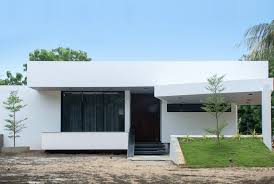Modern housing in Trichy has seen a significant shift over the last decade. While apartment design trends continue to progress with new materials and compact layouts, many Trichy flats have started integrating traditional architectural elements into their overall design. This blend of old and new does more than just create a visual appeal. It offers practical advantages while respecting cultural identity.
Let us look at how traditional architecture elements contribute to the charm and function of modern flats in Trichy.
Courtyards: Bringing Light and Airflow
One of the most prominent features in traditional South Indian homes is the central courtyard. This space was used for various household activities and served as a natural source of light and ventilation.
In several modern Trichy flats, developers have included open courtyards or atrium spaces in their layout. This provides a better airflow system and helps keep indoor temperatures lower without complete dependence on artificial cooling. It also creates a quiet space inside the home, away from external noise.
Although many flats do not offer large courtyards due to space constraints, partial adaptations such as open-to-sky balconies or vertical atriums are being used with similar benefits.
Sloped Roofing and Terracotta Tiles
Sloped roofs with clay tiles are a defining aspect of traditional homes in Tamil Nadu. They help in water drainage during the monsoon and reduce heat retention in summer.
Newer flats in Trichy are incorporating sloped roof designs on top floors or common areas like terraces and clubhouses. While modern materials like concrete or metal sheets are used for strength, the design takes visual cues from traditional roofing styles. In some premium flats, developers have also used terracotta-style tiles as an aesthetic overlay.
This method helps maintain the look of heritage architecture while supporting modern structural needs.
Use of Natural Materials
Wooden beams, carved stone pillars, and exposed brickwork were common in older homes. These materials offered strength and aesthetic value. Today, several flats in Trichy adopt these features through modern adaptations.
For example, instead of complete wooden ceilings, decorative wooden panels or beams are used in living rooms. Exposed brick walls or terracotta jalis are added to provide texture and improve air circulation. These elements are used not only for appearance but also for passive cooling, which suits Trichy’s climate.
The result is a flat that looks appealing while also reducing heat retention.
Traditional Arches and Pillars
Architectural designs like arches, pillars, and ornamental brackets are often seen in temple structures and ancestral homes in Tamil Nadu. These have been used in flat entrances, balconies, or common corridors in Trichy housing projects.
While not structurally essential in modern buildings, these design choices help in visually connecting current housing styles with cultural heritage. They add a sense of familiarity and comfort to residents, especially older generations who grew up in such homes.
Temple-Inspired Pooja Rooms
Many buyers in Trichy still value dedicated pooja rooms in their homes. In traditional homes, pooja spaces had ornate wooden doors, niches for lamps, and stone or tile flooring suitable for rituals.
Modern Trichy flats include compact yet well-designed pooja areas with decorative woodwork, recessed lighting, and natural stone tiles. These spaces are designed to fit within limited square footage while still holding on to the traditional appearance and purpose.
Even in small 2BHK or 3BHK flats, developers try to include such features based on buyer preference.
Verandahs and Sit-Out Spaces
In earlier times, homes had large verandahs at the entrance where residents could sit and relax during the evenings. Though not as spacious in flats, a similar concept is used through extended balconies or common seating areas.
In many Trichy flats, balconies are given additional width and covered partially with tile or wood cladding to create a similar environment. Ground floor flats sometimes offer small sit-out areas that mimic the feel of a traditional front porch.
Such additions improve the utility of outdoor spaces and encourage relaxed interactions with neighbors.
Color Palettes Inspired by Tradition
Traditional South Indian homes mostly used earthy tones, reds, browns, and muted yellows. These colors blend with natural materials and suit the region’s warm weather.
Modern Trichy flats are adopting similar tones for external walls, common areas, and even in interior finishes. Instead of bright synthetic colors, soft earthy shades are used for a more grounded and calming look.
This also ties in well with the use of natural materials like clay tiles and brick.
The Balance Between Tradition and Utility
Incorporating traditional elements does not mean going back in time. Instead, it is a thoughtful addition to improve both the look and functionality of modern housing.
For buyers of Trichy flats, these features offer a sense of connection with local culture while enjoying modern conveniences like elevators, modular kitchens, and security systems.
Developers also find that adding such design elements increases interest from both local and NRI buyers, especially those looking for homes that reflect regional identity.
Conclusion
Modern Trichy flats are evolving to meet the needs of today’s residents while also drawing inspiration from traditional Tamil architecture. From courtyards and sloped roofs to decorative pillars and pooja spaces, these elements are used not just for style, but also for practical benefits like airflow, natural cooling, and cultural relevance.
As more people look for homes that offer both comfort and familiarity, this design blend is likely to continue. Rather than replacing the old, modern flats in Trichy are finding smart ways to bring traditional architecture forward into present-day living.

